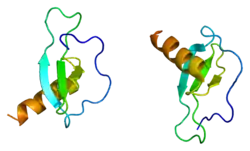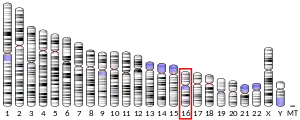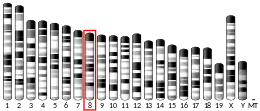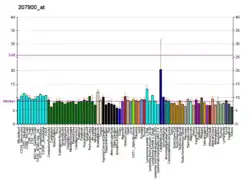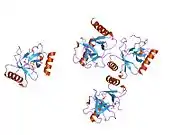CCL17
Chemokine (C-C motif) ligand 17 (CCL17) (also known as TARC) is a small cytokine belonging to the CC chemokine family is also known as thymus and activation regulated chemokine (TARC). CCL17 is expressed constitutively in thymus, but only transiently in phytohemagglutinin-stimulated peripheral blood mononuclear cells.[5] This chemokine specifically binds and induces chemotaxis in T cells and elicits its effects by interacting with the chemokine receptor CCR4.[5][6] The gene for CCL17 is located on chromosome 16, in humans, along with other chemokines called CCL22 and CX3CL1.[7][8]
Granulocyte-macrophage colony-stimulating factor (GM-CSF) upregulates CCL17 production in monocytes and macrophages.[9] Neutralizing CCL17 with monoclonal antibody has been shown to relieve inflammatory arthritis and osteoarthritis.[9]
References
- GRCh38: Ensembl release 89: ENSG00000102970 - Ensembl, May 2017
- GRCm38: Ensembl release 89: ENSMUSG00000031780 - Ensembl, May 2017
- "Human PubMed Reference:". National Center for Biotechnology Information, U.S. National Library of Medicine.
- "Mouse PubMed Reference:". National Center for Biotechnology Information, U.S. National Library of Medicine.
- Imai T, Yoshida T, Baba M, Nishimura M, Kakizaki M, Yoshie O (1996). "Molecular cloning of a novel T cell-directed CC chemokine expressed in thymus by signal sequence trap using Epstein-Barr virus vector". J. Biol. Chem. 271 (35): 21514–21. doi:10.1074/jbc.271.35.21514. PMID 8702936.
- Imai T, Baba M, Nishimura M, Kakizaki M, Takagi S, Yoshie O (1997). "The T cell-directed CC chemokine TARC is a highly specific biological ligand for CC chemokine receptor 4". J. Biol. Chem. 272 (23): 15036–42. doi:10.1074/jbc.272.23.15036. PMID 9169480.
- Nomiyama H, Imai T, Kusuda J, Miura R, Callen DF, Yoshie O (1997). "Assignment of the human CC chemokine gene TARC (SCYA17) to chromosome 16q13". Genomics. 40 (1): 211–3. doi:10.1006/geno.1996.4552. PMID 9070951.
- Nomiyama H, Imai T, Kusuda J, Miura R, Callen DF, Yoshie O (1998). "Human chemokines fractalkine (SCYD1), MDC (SCYA22) and TARC (SCYA17) are clustered on chromosome 16q13". Cytogenet. Cell Genet. 81 (1): 10–1. doi:10.1159/000015000. PMID 9691168. S2CID 46851784.
- Lee K, Achuthan AA, Hamilton JA (2020). "GM-CSF: A Promising Target in Inflammation and Autoimmunity". ImmunoTargets and Therapy. 9: 225–240. doi:10.2147/ITT.S262566. PMC 7605919. PMID 33150139.
Further reading
- Saeki H, Tamaki K (2006). "Thymus and activation regulated chemokine (TARC)/CCL17 and skin diseases". J. Dermatol. Sci. 43 (2): 75–84. doi:10.1016/j.jdermsci.2006.06.002. PMID 16859899.
- Imai T, Yoshida T, Baba M, et al. (1996). "Molecular cloning of a novel T cell-directed CC chemokine expressed in thymus by signal sequence trap using Epstein-Barr virus vector". J. Biol. Chem. 271 (35): 21514–21. doi:10.1074/jbc.271.35.21514. PMID 8702936.
- Nomiyama H, Imai T, Kusuda J, et al. (1997). "Assignment of the human CC chemokine gene TARC (SCYA17) to chromosome 16q13". Genomics. 40 (1): 211–3. doi:10.1006/geno.1996.4552. PMID 9070951.
- Imai T, Baba M, Nishimura M, et al. (1997). "The T cell-directed CC chemokine TARC is a highly specific biological ligand for CC chemokine receptor 4". J. Biol. Chem. 272 (23): 15036–42. doi:10.1074/jbc.272.23.15036. PMID 9169480.
- Imai T, Chantry D, Raport CJ, et al. (1998). "Macrophage-derived chemokine is a functional ligand for the CC chemokine receptor 4". J. Biol. Chem. 273 (3): 1764–8. doi:10.1074/jbc.273.3.1764. PMID 9430724.
- Bernardini G, Hedrick J, Sozzani S, et al. (1998). "Identification of the CC chemokines TARC and macrophage inflammatory protein-1 beta as novel functional ligands for the CCR8 receptor". Eur. J. Immunol. 28 (2): 582–8. doi:10.1002/(SICI)1521-4141(199802)28:02<582::AID-IMMU582>3.0.CO;2-A. PMID 9521068.
- Nomiyama H, Imai T, Kusuda J, et al. (1998). "Human chemokines fractalkine (SCYD1), MDC (SCYA22) and TARC (SCYA17) are clustered on chromosome 16q13". Cytogenet. Cell Genet. 81 (1): 10–1. doi:10.1159/000015000. PMID 9691168. S2CID 46851784.
- Struyf S, Proost P, Sozzani S, et al. (1998). "Enhanced anti-HIV-1 activity and altered chemotactic potency of NH2-terminally processed macrophage-derived chemokine (MDC) imply an additional MDC receptor". J. Immunol. 161 (6): 2672–5. PMID 9743322.
- Loftus BJ, Kim UJ, Sneddon VP, et al. (1999). "Genome duplications and other features in 12 Mb of DNA sequence from human chromosome 16p and 16q". Genomics. 60 (3): 295–308. doi:10.1006/geno.1999.5927. PMID 10493829.
- Garlisi CG, Xiao H, Tian F, et al. (1999). "The assignment of chemokine-chemokine receptor pairs: TARC and MIP-1 beta are not ligands for human CC-chemokine receptor 8". Eur. J. Immunol. 29 (10): 3210–5. doi:10.1002/(SICI)1521-4141(199910)29:10<3210::AID-IMMU3210>3.0.CO;2-W. PMID 10540332.
- Dias Neto E, Correa RG, Verjovski-Almeida S, et al. (2000). "Shotgun sequencing of the human transcriptome with ORF expressed sequence tags". Proc. Natl. Acad. Sci. U.S.A. 97 (7): 3491–6. doi:10.1073/pnas.97.7.3491. PMC 16267. PMID 10737800.
- Ghia P, Transidico P, Veiga JP, et al. (2001). "Chemoattractants MDC and TARC are secreted by malignant B-cell precursors following CD40 ligation and support the migration of leukemia-specific T cells". Blood. 98 (3): 533–40. doi:10.1182/blood.V98.3.533. PMID 11468146.
- Morita A, Kikuoka S, Horikawa T, et al. (2002). "Evaluation of human thymus and activation-regulated chemokine concentrations in blood using a new sandwich ELISA based on monoclonal antibodies". Clin. Chim. Acta. 322 (1–2): 67–75. doi:10.1016/S0009-8981(02)00131-6. PMID 12104083.
- Basu S, Schaefer TM, Ghosh M, et al. (2003). "Molecular cloning and sequencing of 25 different rhesus macaque chemokine cDNAs reveals evolutionary conservation among C, CC, CXC, AND CX3C families of chemokines". Cytokine. 18 (3): 140–8. doi:10.1006/cyto.2002.0875. PMID 12126650.
- D'Ambrosio D, Albanesi C, Lang R, et al. (2002). "Quantitative differences in chemokine receptor engagement generate diversity in integrin-dependent lymphocyte adhesion". J. Immunol. 169 (5): 2303–12. doi:10.4049/jimmunol.169.5.2303. PMID 12193695.
- Matsumoto N, Mukae H, Nakamura-Uchiyama F, et al. (2002). "Elevated levels of thymus and activation-regulated chemokine (TARC) in pleural effusion samples from patients infested with Paragonimus westermani". Clin. Exp. Immunol. 130 (2): 314–8. doi:10.1046/j.1365-2249.2002.01985.x. PMC 1906524. PMID 12390321.
- Zheng X, Nakamura K, Tojo M, et al. (2003). "TGF-beta1-mediated regulation of thymus and activation-regulated chemokine (TARC/CCL17) synthesis and secretion by HaCaT cells co-stimulated with TNF-alpha and IFN-gamma". J. Dermatol. Sci. 30 (2): 154–60. doi:10.1016/S0923-1811(02)00071-3. PMID 12413771.
- Kakinuma T, Nakamura K, Wakugawa M, et al. (2003). "IL-4, but not IL-13, modulates TARC (thymus and activation-regulated chemokine)/CCL17 and IP-10 (interferon-induced protein of 10kDA)/CXCL10 release by TNF-alpha and IFN-gamma in HaCaT cell line". Cytokine. 20 (1): 1–6. doi:10.1006/cyto.2002.1965. PMID 12441140.
- Uchida T, Suto H, Ra C, et al. (2003). "Preferential expression of T(h)2-type chemokine and its receptor in atopic dermatitis". Int. Immunol. 14 (12): 1431–8. doi:10.1093/intimm/dxf109. PMID 12456591.
- Strausberg RL, Feingold EA, Grouse LH, et al. (2003). "Generation and initial analysis of more than 15,000 full-length human and mouse cDNA sequences". Proc. Natl. Acad. Sci. U.S.A. 99 (26): 16899–903. doi:10.1073/pnas.242603899. PMC 139241. PMID 12477932.
- Jones, K (Feb 1, 2013). "Serum CD163 and TARC as disease response biomarkers in classical Hodgkin lymphoma". Clin Cancer Res. 19 (3): 731–42. doi:10.1158/1078-0432.CCR-12-2693. PMID 23224400.
External links
- Human CCL17 genome location and CCL17 gene details page in the UCSC Genome Browser.
